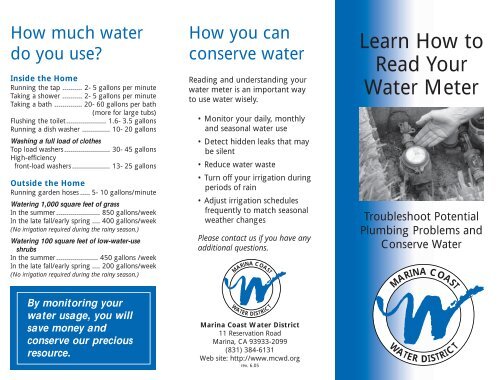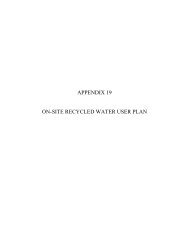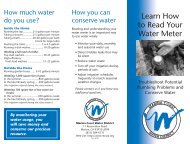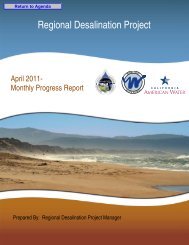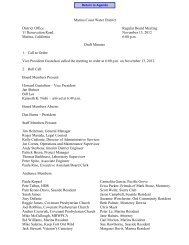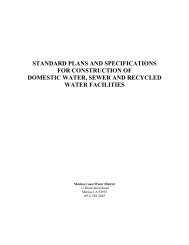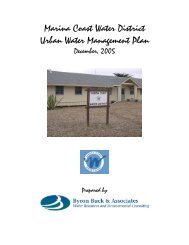Water Meter Brochure - Marina Coast Water District
Water Meter Brochure - Marina Coast Water District
Water Meter Brochure - Marina Coast Water District
Create successful ePaper yourself
Turn your PDF publications into a flip-book with our unique Google optimized e-Paper software.
How much water<br />
do you use<br />
Inside the Home<br />
Running the tap .......... 2- 5 gallons per minute<br />
Taking a shower .......... 2- 5 gallons per minute<br />
Taking a bath .............. 20- 60 gallons per bath<br />
(more for large tubs)<br />
Flushing the toilet.................... 1.6- 3.5 gallons<br />
Running a dish washer .............. 10- 20 gallons<br />
Washing a full load of clothes<br />
Top load washers....................... 30- 45 gallons<br />
High-efficiency<br />
front-load washers ................... 13- 25 gallons<br />
Outside the Home<br />
Running garden hoses ..... 5- 10 gallons/minute<br />
<strong>Water</strong>ing 1,000 square feet of grass<br />
In the summer ...................... 850 gallons/week<br />
In the late fall/early spring .... 400 gallons/week<br />
(No irrigation required during the rainy season.)<br />
<strong>Water</strong>ing 100 square feet of low-water-use<br />
shrubs<br />
In the summer ..................... 450 gallons /week<br />
In the late fall/early spring .... 200 gallons/week<br />
(No irrigation required during the rainy season.)<br />
How you can<br />
conserve water<br />
Reading and understanding your<br />
water meter is an important way<br />
to use water wisely.<br />
• Monitor your daily, monthly<br />
and seasonal water use<br />
• Detect hidden leaks that may<br />
be silent<br />
• Reduce water waste<br />
• Turn off your irrigation during<br />
periods of rain<br />
• Adjust irrigation schedules<br />
frequently to match seasonal<br />
weather changes<br />
Please contact us if you have any<br />
additional questions.<br />
MARINA COAST<br />
Learn How to<br />
Read Your<br />
<strong>Water</strong> <strong>Meter</strong><br />
Troubleshoot Potential<br />
Plumbing Problems and<br />
Conserve <strong>Water</strong><br />
By monitoring your<br />
water usage, you will<br />
save money and<br />
conserve our precious<br />
resource.<br />
WATER<br />
DISTRICT<br />
<strong>Marina</strong> <strong>Coast</strong> <strong>Water</strong> <strong>District</strong><br />
11 Reservation Road<br />
<strong>Marina</strong>, CA 93933-2099<br />
(831) 384-6131<br />
Web site: http://www.mcwd.org<br />
rev. 6.05<br />
MARINA COAST<br />
WATER<br />
DISTRICT
How to read your water meter by the numbers<br />
1. Locate your meter<br />
<strong>Water</strong> meters are usually located near the curb<br />
in front of the house or place of business. They<br />
are below ground housed in a box usually<br />
marked <strong>Water</strong>. Carefully remove the meter<br />
box lid and visually examine the area around<br />
the meter to ensure your safety (spiders are<br />
known to nest in meter boxes). A cap is installed<br />
to cover the face of the meter. If it is<br />
down, lift the cap to see the face of the meter.<br />
2. Read your meter<br />
Reading a water meter is similar to reading an<br />
automobile odometer. Most meters have a sixdigit<br />
number on the face called the readout<br />
(see illustration). This shows the total number<br />
of cubic feet used since the meter was installed.<br />
<strong>Water</strong> passing through the meter<br />
turns the sweephand and revolves the<br />
readout numbers. One complete rotation<br />
of the sweephand equals one cubic<br />
foot of water used.<br />
Readout<br />
NOTE: MCWD charges for water use by<br />
the one hundred cubic feet (HCF), or units<br />
of water used. This is the third digit from<br />
the right on the readout. The last two digits<br />
on the right, which may be painted on the<br />
face of the meter, are not used to calculate<br />
units of water used.<br />
Sweephand<br />
Low-flow Indicator<br />
3. Calculate your water use<br />
To calculate your water use, record the number<br />
appearing on the face of the meter along with<br />
the time and date. A day or two later, read<br />
your meter again. Subtract the first reading<br />
from the second to find how much water was<br />
used during that time. For example:<br />
Second reading 515,0(00) HCF<br />
First reading -514,5(00) HCF<br />
<strong>Water</strong> used<br />
5(00) HCF<br />
or 5 units<br />
▲<br />
▲<br />
▲<br />
4. Monitor your water use<br />
You will find a graph showing your water<br />
usage history on your monthly bill. You can<br />
compare your water use monthly, seasonally or<br />
yearly. If your household water use changes in<br />
any way (e.g. new family member, irrigation or<br />
plumbing changes), you will be able to monitor<br />
the effects of that change.<br />
5. Checking for leaks<br />
The little triangle or spoked wheel on the face<br />
of the meter is the low-flow indicator. Even<br />
when water flows are low, it will rotate. To<br />
check for leaks, turn off all water sources inside<br />
and outside the building. (If you have an<br />
automatic ice maker, make sure it is not in<br />
operation.) When all water is turned off,<br />
the low-flow indicator should not move.<br />
If the low-flow indicator is moving,<br />
there is water flowing somewhere on<br />
your property. Turn off the shut-off<br />
valve (usually located near the water<br />
pipe going inside the building).<br />
If the low-flow indicator stops<br />
moving when the valve is off,<br />
there must be a leak somewhere<br />
inside the home. Listening carefully<br />
at each interior fixture can help<br />
pinpoint any leaks. Suspected toilet<br />
leaks can be confirmed by adding<br />
food coloring to the water in the<br />
tank. If the dye travels into the toilet<br />
bowl after several minutes, then you<br />
know you have a leaking flapper valve.


